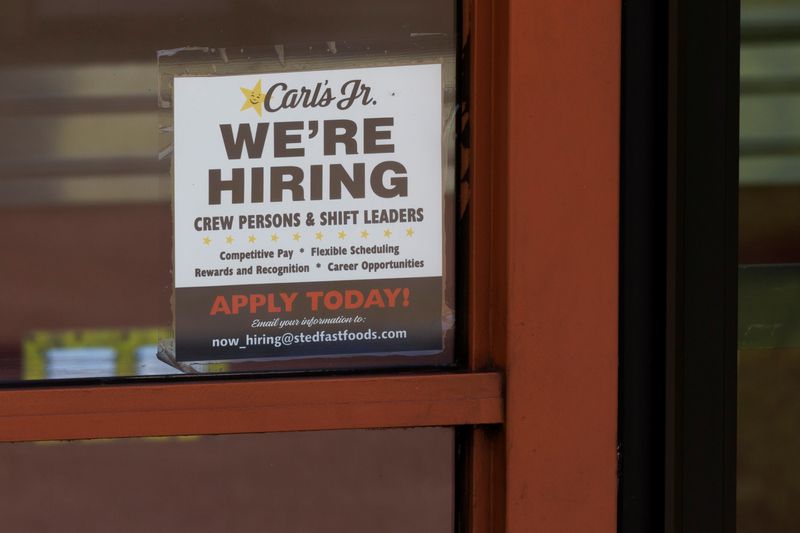Five things to watch in U.S. jobs report: No. 1 – a return to record private employment
2022.07.08 13:41
2/2

FILE PHOTO: A help wanted sign is shown at a fast food restaurant in Solana Beach, California, U.S. November, 9, 2021. REUTERS/Mike Blake
2/2
(Reuters) – Talk of a potential recession is dominating the airwaves and driving frantic action across financial markets, meaning Friday’s U.S. employment report for June will be pored over by investors, politicians and average workers for any signs that the strongest job market in generations is running out of steam.
The worry-warts may not find much to fan their anxiety, if the economists forecasting the key components of the Labor Department’s data are to be believed, even as high inflation and the Federal Reserve’s efforts to contain it through interest rate hikes keep blood pressure high on Main Street and Wall Street.
For one, the private sector – accounting for 85% of all U.S. jobs – may have returned last month to a record level of employment for the first time since the COVID-19 pandemic struck in early 2020. And while job creation likely slowed, it is seen having remained well above the pre-pandemic trend and the jobless rate is forecast to have held fast near half-century lows.
Here are five key factors to eyeball in the report.
RECORD PRIVATE EMPLOYMENT?
Total U.S. employment in May of more than 151 million was still more than 800,000 jobs short of the February 2020 record high. The expectation for nearly 270,000 new jobs in June would further trim that deficit, but is unlikely to close it altogether.
The big news may be in the private sector. According to the Reuters forecast for 240,000 new positions, private employment should climb to nearly 130 million and erase what was left of the corporate employment hole carved by the pandemic.
Nonetheless, even that milestone comes with caveats: Substantial gaps will remain in the hardest-hit industries, especially leisure and hospitality.
GRAPHIC: U.S. private employment https://graphics.reuters.com/USA-ECONOMY/JOBS/gkvlgerkopb/chart.png
LAGGING PARTICIPATION RATE
A sore spot in the employment recovery has been the tepid rate of labor force participation. The overall workforce – the total of those working or looking for a job – is only about 250,000 bodies short of the pre-pandemic level, but because the working-age population grew throughout the health crisis, the closely tracked participation rate has been slower to show improvement.
Last at 62.3%, the participation rate is 1.1 percentage points below where it was before the pandemic, at roughly the level that prevailed in the late 1970s. Fed officials like Chair Jerome Powell have pined openly for a return to the rising participation trend that took hold late in the economic expansion that was upended by the pandemic.
GRAPHIC: Workforce participation gap https://graphics.reuters.com/USA-ECONOMY/JOBS/gkplgerzevb/chart.png
DEMOGRAPHIC SHIFTS
The participation rate story has some key subplots, including a recent reversal of long-standing racial trends.
Since the Bureau of Labor Statistics began tracking employment data by race in the early 1970s, the participation rate for whites has been sizably above that for Blacks. The tightness of the COVID-recovery job market, though, has provided more opportunity for traditionally disadvantaged groups, and in the last year the Black rate has topped the white rate for the first time, including in April and May of this year.
GRAPHIC: Racial participation gap https://graphics.reuters.com/USA-ECONOMY/JOBS/znpnegygwvl/chart.png
HIRING BREADTH
The demand for workers has rarely been as widespread across private industry groups as it has been in the last year, a factor contributing to the worker supply-demand imbalance.
The BLS tracks that breadth through its Diffusion Index. It hit a record high earlier this year and over the 12 months through May its average level was the highest in a quarter century. The monthly reading had ticked lower in the three reports preceding June, and a further easing last month may indicate that the period of hottest demand for workers has passed.
GRAPHIC: Wage growth https://graphics.reuters.com/USA-ECONOMY/JOBS/byprjazarpe/chart.png
SLOWING WAGE GAINS
Workers during the COVID era have been seeing the largest wage gains in a generation or more, but there are indications that wave may have crested.
The Reuters consensus estimate among economists would put June’s year-over-year increase in average hourly earnings at 5%, a six-month low and the third straight declining rate. That would be welcomed by Fed officials who worry the outsized increases are helping to keep inflation running at its highest rate in 40 years.
GRAPHIC: How broad was the hiring? https://graphics.reuters.com/USA-ECONOMY/JOBS/dwpkrmomlvm/chart.png








